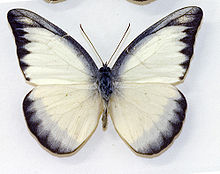| Chocolate albatross | |
|---|---|

| |
| Ventral view | |
| Scientific classification | |
| Domain: | Eukaryota |
| Kingdom: | Animalia |
| Phylum: | Arthropoda |
| Class: | Insecta |
| Order: | Lepidoptera |
| Family: | Pieridae |
| Genus: | Appias |
| Species: | A. lyncida
|
| Binomial name | |
| Appias lyncida Cramer, 1777
| |
| Subspecies | |
| |
| Synonyms | |
Appias lyncida,[3] the chocolate albatross,[4][5] is a butterfly of the family Pieridae, that is, the yellows and whites, which is found in south and southeast Asia.[4][5]
Range[edit]
The chocolate albatross is found in India, China, Sri Lanka, Myanmar, Malaysia, Indonesia, Philippines, Thailand, Laos, Indochina, Taiwan, Hainan and possibly South China.[4][5]
In India, the butterfly ranges across south India, Nicobar islands, Sikkim to Assam, and onto Myanmar.[4][5] In South India, the chocolate albatross is to be found along the foot of the Western Ghats. It is found throughout the year in the Nilgiris where it is locally common. In the northern parts of peninsular India it extends into Orissa and north up to Lucknow.[6]
Status[edit]
In India, the northern race of the butterfly is common, while it is local and scarce in other parts of its range.[6]
Description[edit]

The chocolate albatross has a wingspan of 55 to 70 mm. The male is white above with chocolate-brown or black margins, and, bright lemon yellow below with chocolate-coloured markings. The female is white and densely clouded with dark brown.[7]

The butterfly shows seasonal dimorphism and is very variable. The detailed descriptions are as follows:[6]
- Wet-season form:
- Male - white above, with bluish costa and termen inwardly edged with black teeth-like markings on the forewing. The hindwing is similarly toothed on the termen, which has a bluish inward border. The underside of the hindwing is bright yellow and is outwardly bordered with dark chocolate.[1]
- Female - black upperside of the forewing with four white streaks on the disc. Blackish upperside of the hindwing except for the whitish discal area. The underside of the hindwing may be yellowish or whitish and have broad dark band at the termen.
- Dry-season form: smaller.[1]
- Male - The male has narrower black margins above.[1]
- Female - Similar above to the wet-season form, but with more extensive white markings.[1][2]
Habits[edit]
The chocolate albatross is a forest butterfly and prefers rainy highlands, up to a level of 3,000 feet (910 m). Flying strongly and swiftly close to the ground, the albatross is frequently found in jungle clearings and along stream banks. The males are often found circling around trees and bushes. The chocolate albatross often mudpuddles, sometimes in large numbers. The butterfly occasionally visits flowers and has been recorded to visit Verbena flowers in Kodagu.[6]
Life cycle[edit]
The larvae have been recorded on Crataeva religiosa, Capparis roxburghii and Capparis heyneana.[5]
- Life cycle
-
Eggs on Crateva religiosa
-
Larva
-
Chrysalis
-
Imago (dorsal view)
-
Imago (lateral view; male on right, female on left)
See also[edit]
Notes[edit]
- ^ a b c d e
 One or more of the preceding sentences incorporates text from this source, which is in the public domain: Bingham, C.T. (1907). The Fauna of British India, Including Ceylon and Burma. Vol. II (1st ed.). London: Taylor and Francis, Ltd. pp. 203–205.
One or more of the preceding sentences incorporates text from this source, which is in the public domain: Bingham, C.T. (1907). The Fauna of British India, Including Ceylon and Burma. Vol. II (1st ed.). London: Taylor and Francis, Ltd. pp. 203–205.
- ^ a b Moore, Frederic (1903–1905). Lepidoptera Indica. Vol. VI. London: Lovell Reeve and Co. pp. 199–200.
- ^ Beccaloni, G.; Scoble, M.; Kitching, I.; Simonsen, T.; Robinson, G.; Pitkin, B.; Hine, A.; Lyal, C., eds. (2003). "Appias lyncida". The Global Lepidoptera Names Index. Natural History Museum. Retrieved May 15, 2018.
- ^ a b c d R.K., Varshney; Smetacek, Peter (2015). A Synoptic Catalogue of the Butterflies of India. New Delhi: Butterfly Research Centre, Bhimtal & Indinov Publishing, New Delhi. p. 77. doi:10.13140/RG.2.1.3966.2164. ISBN 978-81-929826-4-9.
- ^ a b c d e Savela, Markku. "Appias Hübner, [1819]". Lepidoptera and Some Other Life Forms. Retrieved May 15, 2018.
- ^ a b c d Wynter-Blyth, Mark Alexander (1957). Butterflies of the Indian Region. Bombay, India: Bombay Natural History Society. pp. 428–429. ISBN 978-8170192329.
- ^ Kunte, Krushnamegh (2000). Butterflies of Peninsular India. India, A Lifescape. Hyderabad, India: Universities Press. pp. 100–101, ser no 23. ISBN 978-8173713545.
References[edit]
- Evans, W.H. (1932). The Identification of Indian Butterflies (2nd ed.). Mumbai, India: Bombay Natural History Society.
- Gaonkar, Harish (1996). Butterflies of the Western Ghats, India (including Sri Lanka) - A Biodiversity Assessment of a Threatened Mountain System. Bangalore, India: Centre for Ecological Sciences.
- Kunte, Krushnamegh (2000). Butterflies of Peninsular India. India, A Lifescape. Hyderabad, India: Universities Press. ISBN 978-8173713545.
- Wynter-Blyth, Mark Alexander (1957). Butterflies of the Indian Region. Bombay, India: Bombay Natural History Society. ISBN 978-8170192329.
- Arun, P. R. (2000). Seasonality and abundance of insects with special reference to butterflies (Lepidoptera: Rhopalocera) in a Moist deciduous forest of Siruvani, Nilgiri Biosphere Reserve, South India Ph.D. Thesis, Bharathiar University, Coimbatore. 236p.
- Haribal, Meena (1992). The Butterflies of Sikkim Himalaya and Their Natural History. Gangtok, Sikkim, India: Sikkim Nature Conservation Foundation.
External links[edit]
- CSIRO Australia EntomID-PNG Specimen Database [1]
- ASEAN centre for Biodiversity [2]
- Photos of Singapore Butterflies The Chocolate Albatross (Archived 2009-10-25)




